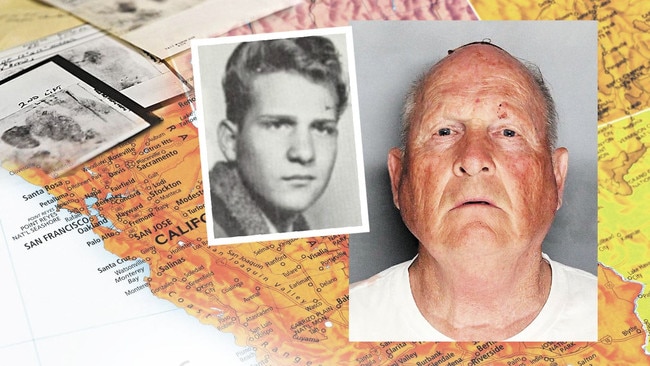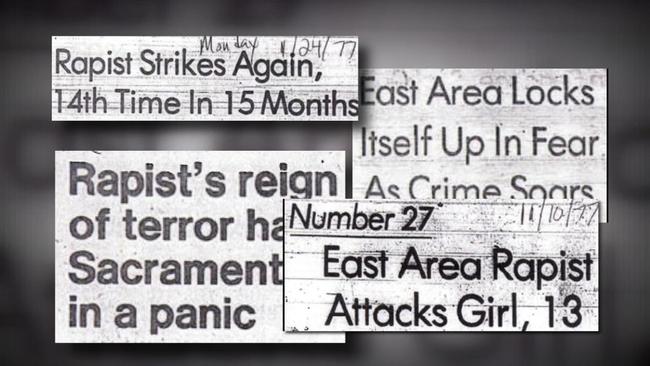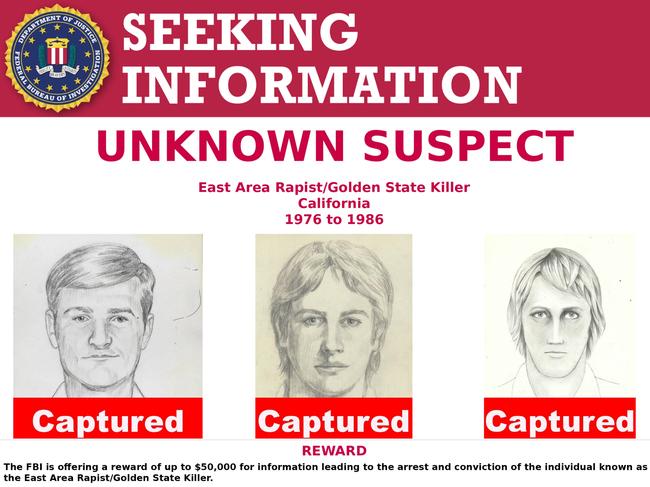Golden State Killer hid in plain sight
It was DNA that finally solved the enduring mystery of a terrifying Golden State crime spree dating back to the 1970s.

It’s the crime spree that captivated the US and beyond: 12 murders, at least 45 rapes and 120 home burglaries across California in the 1970s and 80s. All were connected to one man, who seemed always to be a step ahead of law enforcement and the growing army of citizen sleuths on his trail.
That was until yesterday, when there was an unexpected breakthrough in one of the great crime mysteries, with the Golden State Killer identified as a fleshy 72-year-old former policeman.
A father of adult children, leading an ordinary life in suburban California, his days of prowling yards and rooftops as a fit and strong young man were long behind him.
He was home free, and surely must have been confident he would stay that way until the end of his days.
Until six days before his identity was finally revealed, Joseph James DeAngelo was not even remotely connected to the investigation. Then came a DNA hit.
Authorities have yet to say where this came from.
Perhaps it was through familial testing, which allows offenders to be tracked down through the DNA of relatives — for instance when family members are charged with offences.
Or police could have accessed genealogical websites, to which people submit their DNA to trace family histories.
Time will tell. What is known is that the killer’s DNA had always been there — it was finding a match that was the problem. Tests had never turned anything up.
DeAngelo was put under surveillance. His discarded DNA was obtained and it turned out to be a match, US authorities say; the man everyone was looking for was apparently hiding in plain sight.
The scale and terror involved in the Golden State Killer’s crimes — chronicled in the bestselling new book I’ll be Gone in the Dark, several recent podcast series and a television documentary — is almost unparalleled.

He began by sexually assaulting women who were at home alone or with young children. But after a local newspaper reported that the serial rapist plaguing the area was attacking only women, he upped the ante, targeting a couple in his next attack. It seemed he was reading his own press and responding to the challenge.
His signature was a ski mask and commands issued through clenched teeth, for effect or to disguise his voice.
Everything was designed to cause maximum terror. Victims would wake in the early hours of the morning to find him standing in their bedrooms, naked from the waist down.
On one occasion he reportedly even removed bullets from a householder’s gun before he woke him, allowing the man to reach for the weapon, only to find it useless.
For all the humiliation and pain he inflicted on his victims, many are happy to put a name and a face to a predator whose defining physical trait for the past 40 years has been his unusually small penis; he was uniformly described as being under-endowed.
Another defining attribute reported by some of his victims was a foul odour — dogs brought in to track him reportedly reacted in a way that suggested he had a serious illness or was a drug abuser.
Bizarrely, he would remain in victims’ homes for long periods, pausing attacks to help himself to food from their kitchens.
Men would be left bound on beds, with dinner plates stacked on their backs to alert him to any movement, while their partners were sexually assaulted in a separate room.
During his reign of terror in California, no one was safe. People who barricaded their homes woke to find he had somehow pierced their defences.
He toyed with blindfolded victims after attacks, remaining silent for long periods so they would think he had left their home, but pouncing on them when they moved. Many victims reported hung-up calls preceding attacks; others received terrifying calls after attacks, sometimes years later.
A 1978 recording of one of these chilling calls was officially released by investigators. It was recorded after detectives tapped a rape victim’s phone. The sound of exaggerated, heavy breathing is followed by a whispered threat: “I’m gonna kill you. Gonna kill you. Gonna kill you. Bitch.”
Another phone call was reported to have been made to a victim in 2001, 24 years after she was attacked. “Do you remember when we played?” the caller whispered. She recognised the caller’s voice as that of her attacker.
There were many junctures at which it seemed almost certain the Golden State Killer would be caught, and his anger shone through when victims challenged him. Detective Sergeant Ken Clark of the Sacramento Sheriff’s County Department detailed one of these instances last month in the podcast Unmasking a Killer. Clark had spoken to a homeowner on Haskell Avenue, Carmichael, a big, “kind of a biker” guy who saw someone peering into his kitchen window in May 1977.
“He said, ‘I remember it like yesterday … this guy just had everyone on edge, my wife was scared, everyone was scared,’ ” Clark told the podcast.
Running to his door, the homeowner saw the intruder vault a fence, and gave chase.
Police were called and a helicopter pursuit ensued. The culprit slipped through the net but was enraged.
Police went back to the man’s house the next night because the owner woke to find a note on his doorstep written on a religious pamphlet.
“Allmost (sic) got me. Next time you die,” the note said.
The same homeowner got an alarm fitted but returned home with his wife one day to find the bathroom window open with the screen off.
There were footsteps on top of the washing machine, under the roof access hatch — the alarm had been installed in the roof cavity.
“It’s like he was probing the system; like he was trying to figure out how can I surprise these people that I don’t like and defeat this alarm system in such a way that when they least expect me I’m going to pop out,” Clark said.
“And I think he probably would have killed them. I think he was that angry with this guy. But it ends up that he never goes back.”
Burglaries and rapes escalated to murder.
Brian and Katie Maggiore were shot dead while walking their dog in Rancho Cordova in 1978; it was speculated that this, the first of his murders, might have occurred after they recognised the culprit.
Charlene and Lyman Smith were bludgeoned to death with a fireplace log in March 1980.
The last known victim, Janelle Cruz, was bludgeoned to death, likely with a pipe wrench, in Irvine in 1986.
Due in part to his skills in evading capture, there has always been a suspicion the Golden State Killer was involved in law enforcement. But for it to be confirmed with an arrest is another thing entirely.

Word first started leaking out online on Wednesday afternoon Australian time that the hunt for the Golden State Killer was finally over.
Within hours, well before the arrest had been officially confirmed, true-crime researchers tracked down and reposted an old news story about DeAngelo’s dismissal as a police officer.
The report said he had been caught shoplifting a can of dog repellent and a hammer at a Sacramento drugstore. “Auburn Policeman Dismissed In Shoplifting Accusation,” the headline reads.
It was bound to be the case that if the killer were ever identified, everything would fall into place.
And that’s what is already happening.
For instance, debate has raged over whether the Golden State Killer also was responsible for an earlier set of crimes involving dozens of burglaries and home invasions in Visalia, California.
These occurred between 1974 and 1975 and were attributed to a man given the moniker the Visalia Ransacker. It was confirmed yesterday that DeAngelo had worked with the police department in Exeter, near Visalia, from 1973 to 1976, before leaving for Auburn.
Visalia police chief Jason Salazar is confident of tying DeAngelo to the Ransacker cases.
Many wondered how the killer found the time to plan and implement his assaults.
Whether he was prowling and attacking while at work as a police officer is now part of the huge investigation under way into his background.
From June 1976 to February 1978, he operated in the Greater Sacramento area, and from 1979 to 1986 he was in southern California. It was only in 2001 that DNA evidence linked these offences.
The victims ranged in age from 13 to 41.
Before the dots were connected, he had been known as both the East Area Rapist and the Original Night Stalker (as distinct from Richard Ramirez, the serial killer dubbed the Night Stalker).
It was true-crime blogger and writer Michelle McNamara who replaced his convoluted moniker with a single title: the Golden State Killer.
In a 2013 profile for Los Angeles Magazine, she wrote about how the killer would “rant to his victims about needing money, but he frequently ignored cash, even when it was right in front of him”.
“But he didn’t leave empty-handed. He took items of personal value from those he had violated: engraved wedding bands, driver’s licences, souvenir coins.”
She added that “neither the Zodiac Killer, who terrorised San Francisco in the late 1960s and early 70s, nor the Night Stalker, who had southern Californians locking their windows in the 80s, was as active”.
“Yet the Golden State Killer has little recognition; he didn’t even have a catchy name until I coined one.”
McNamara was writing the book I’ll be Gone in the Dark when she died in 2016. It was completed posthumously and published earlier this year.
Investigators yesterday bluntly noted the book played no part in the discovery of the crucial new evidence, but no one could doubt the impact of her writing.
Until recently the Golden State Killer had been the most intriguing and prolific serial killer almost nobody had heard of. McNamara drove the story, putting it in the public eye years before the FBI and country sheriffs issued a major public appeal for information in June 2016.
Such has been the recent spate of publicity around the Golden State Killer that one retired US detective came forward with a tip that a suspect could have moved to Australia and died in a car crash.
Earlier this week The Australian revealed Victoria Police had examined the US case and definitively ruled out a connection to Mr Cruel, who terrorised Melbourne with a series of attacks on girls in their homes in the late 80s and early 90s.
As we now know from the police case outlined yesterday, the accused Golden State Killer was alive and well, and living in a nice house at Citrus Heights, Sacramento County.
“Joseph James DeAngelo has been called a lot of things,” Orange County District Attorney Tony Rackauckas said yesterday.
“He’s been called the East Area Rapist. He’s been called the Visalia Ransacker, the Original Night Stalker and the Golden State Killer.
“Today it is our pleasure to call him defendant.”

